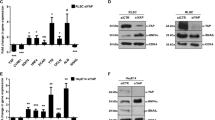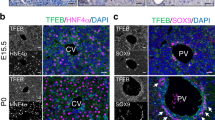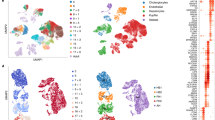Abstract
Although advances have been made in understanding cell differentiation, only rudimentary knowledge exists concerning how differentiated cells form tissues and organs. We studied liver organogenesis because the cell and tissue architecture of this organ is well defined. Approximately 60% of the adult liver consists of hepatocytes that are arranged as single-cell anastomosing plates extending from the portal region of the liver lobule toward the central vein1. The basal surface of the hepatocytes is separated from adjacent sinusoidal endothelial cells by the space of Disse, where the exchange of substances between serum and hepatocytes takes place. The hepatocyte's apical surface forms bile canaliculi that transport bile to the hepatic ducts. Proper liver architecture is crucial for hepatic function2 and is commonly disrupted in disease states, including cirrhosis and hepatitis3. Here we report that hepatocyte nuclear factor 4α (Hnf4α) is essential for morphological and functional differentiation of hepatocytes4, accumulation of hepatic glycogen stores and generation of a hepatic epithelium. We show that Hnf4α is a dominant regulator of the epithelial phenotype because its ectopic expression in fibroblasts induces a mesenchymal-to-epithelial transition. Most importantly, the morphogenetic parameters controlled by Hnf4α in hepatocytes are essential for normal liver architecture, including the organization of the sinusoidal endothelium.
This is a preview of subscription content, access via your institution
Access options
Subscribe to this journal
Receive 12 print issues and online access
$209.00 per year
only $17.42 per issue
Buy this article
- Purchase on Springer Link
- Instant access to full article PDF
Prices may be subject to local taxes which are calculated during checkout





Similar content being viewed by others
References
Blouin, A., Bolender, R.P. & Weibel, E.R. Distribution of organelles and membranes between hepatocytes and nonhepatocytes in the rat liver parenchyma. A stereological study. J. Cell. Biol. 72, 441–455 (1977).
Kmiec, Z. Cooperation of liver cells in health and disease. Adv. Anat. Embryol. Cell. Biol. 161, 1–151 (2001).
Sherlock, S. & Dooley, J. Hepatic cirrhosis. in Diseases of the Liver and Biliary System 371–382 (Blackwell Science, Oxford, 1997).
Li, J., Ning, G. & Duncan, S.A. Mammalian hepatocyte differentiation requires the transcription factor HNF-4α. Genes Dev. 14, 464–474 (2000).
Chen, W.S. et al. Disruption of the HNF-4 gene, expressed in visceral endoderm, leads to cell death in embryonic ectoderm and impaired gastrulation of mouse embryos. Genes Dev. 8, 2466–2477 (1994).
Duncan, S.A., Nagy, A. & Chan, W. Murine gastrulation requires HNF-4 regulated gene expression in the visceral endoderm: tetraploid rescue of HNF-4−/− embryos. Development 124, 279–287 (1997).
Parviz, F., Li, J., Kaestner, K.H. & Duncan, S.A. Generation of a conditionally null allele of Hnf4α. Genesis 32, 130–133 (2002).
Hayhurst, G.P., Lee, Y.H., Lambert, G., Ward, J.M. & Gonzalez, F.J. Hepatocyte nuclear factor 4α (nuclear receptor 2A1) is essential for maintenance of hepatic gene expression and lipid homeostasis. Mol. Cell. Biol. 21, 1393–1403 (2001).
Hall, R.K., Sladek, F.M. & Granner, D.K. The orphan receptors COUP-TF and HNF-4 serve as accessory factors required for induction of phosphoenolpyruvate carboxykinase gene transcription by glucocorticoids. Proc. Natl. Acad. Sci. USA 92, 412–416 (1995).
Boustead, J.N. et al. Hepatocyte nuclear factor-4α (HNF-4α) mediates the stimulatory effect of peroxisome proliferator activated receptor γ coactivator-1α (PGC-1α) on glucose-6-phosphatase catalytic subunit gene transcription in H4IIE cells. Biochem. J. 369, 17–22 (2003).
Vassy, J., Kraemer, M., Chalumeau, M.T. & Foucrier, J. Development of the fetal rat liver: ultrastructural and stereological study of hepatocytes. Cell. Differ. 24, 9–24 (1988).
Medlock, E.S. & Haar, J.L. The liver hemopoietic environment: I. Developing hepatocytes and their role in fetal hemopoiesis. Anat. Rec. 207, 31–41 (1983).
Feracci, H., Connolly, T.P., Margolis, R.N. & Hubbard, A.L. The establishment of hepatocyte cell surface polarity during fetal liver development. Dev. Biol. 123, 73–84 (1987).
Wood, R.L. An electron microscope study of the developing bile canaliculi in the rat. Anat. Rec. 151, 507–503 (1965).
De Wolf-Peeters, C., De Vos, R., Desmet, V., Bianchi, L. & Rohr, H.P. Electron microscopy and morphometry of canalicular differentiation in fetal and neonatal rat liver. Exp. Mol. Pathol. 21, 339–350 (1974).
Daniels, E. et al. Biliary glycoprotein 1 expression during embryogenesis: correlation with events of epithelial differentiation, mesenchymal-epithelial interactions, absorption, and myogenesis. Dev. Dyn. 206, 272–290 (1996).
Cascio, S. & Zaret, K.S. Hepatocyte differentiation initiates during endodermal-mesenchymal interactions prior to liver formation. Development 113, 217–225 (1991).
Spath, G.F. & Weiss, M.C. Hepatocyte nuclear factor 4 expression overcomes repression of the hepatic phenotype in dedifferentiated hepatoma cells. Mol. Cell. Biol. 17, 1913–1922 (1997).
Spath, G.F. & Weiss, M.C. Hepatocyte nuclear factor 4 provokes expression of epithelial marker genes, acting as a morphogen in dedifferentiated hepatoma cells. J. Cell. Biol. 140, 935–946 (1998).
Sladek, F.M., Zhong, W., Lai, E. & Darnell, J.E., Jr. Liver-enriched transcription factor HNF-4 is a novel member of the steroid hormone receptor superfamily. Genes. Dev. 4, 2353–2365 (1990).
Pear, W.S., Nolan, G.P., Scott, M.L. & Baltimore, D. Production of high-titer helper-free retroviruses by transient transfection. Proc. Natl. Acad. Sci. USA 90, 8392–8396 (1993).
Morgenstern, J.P. & Land, H. Advanced mammalian gene transfer: high titre retroviral vectors with multiple drug selection markers and a complementary helper-free packaging cell line. Nucleic Acids Res. 18, 3587–3596 (1990).
Enzan, H. et al. Development of hepatic sinusoidal structure with special reference to the Ito cells. Microsc. Res. Tech. 39, 336–349 (1997).
Duncan, S.A. et al. Expression of transcription factor HNF-4 in the extraembryonic endoderm, gut, and nephrogenic tissue of the developing mouse embryo: HNF-4 is a marker for primary endoderm in the implanting blastocyst. Proc. Natl. Acad. Sci. USA 91, 7598–7602 (1994).
Taraviras, S., Monaghan, A.P., Schutz, G. & Kelsey, G. Characterization of the mouse HNF-4 gene and its expression during mouse embryogenesis. Mech. Dev. 48, 67–79 (1994).
Sund, N.J. et al. Hepatocyte nuclear factor 3β (Foxa2) is dispensable for maintaining the differentiated state of the adult hepatocyte. Mol. Cell. Biol. 20, 5175–5183 (2000).
Acknowledgements
We thank J. Morrison for early guidance, N. Lazarevitch for advice on PCR primers, P. Traktman for critical input, N. Beauchemin for antibodies to CEACAM1 and J. Burke and D. Lourim for advice on antibodies to E-cadherin and ZO1. Funding for this project was provided by American Heart Association fellowships to F.P. and W.D.G., a Human Frontiers Science Program grant to K.S.Z. and S.A.D. and grants from the US National Institutes of Health to K.S.Z. and S.A.D.
Author information
Authors and Affiliations
Corresponding author
Ethics declarations
Competing interests
The authors declare no competing financial interests.
Rights and permissions
About this article
Cite this article
Parviz, F., Matullo, C., Garrison, W. et al. Hepatocyte nuclear factor 4α controls the development of a hepatic epithelium and liver morphogenesis. Nat Genet 34, 292–296 (2003). https://doi.org/10.1038/ng1175
Received:
Accepted:
Published:
Issue Date:
DOI: https://doi.org/10.1038/ng1175
This article is cited by
-
Potential advantages of genetically modified mesenchymal stem cells in the treatment of acute and chronic liver diseases
Stem Cell Research & Therapy (2023)
-
The lncRNA HOTAIR: a pleiotropic regulator of epithelial cell plasticity
Journal of Experimental & Clinical Cancer Research (2023)
-
TRPM8 deficiency attenuates liver fibrosis through S100A9-HNF4α signaling
Cell & Bioscience (2022)
-
Metabolic regulation of cholestatic liver injury by D-2-hydroxyglutarate with the modulation of hepatic microenvironment and the mammalian target of rapamycin signaling
Cell Death & Disease (2022)
-
Loss of FOXA2 induces ER stress and hepatic steatosis and alters developmental gene expression in human iPSC-derived hepatocytes
Cell Death & Disease (2022)



